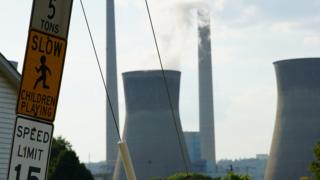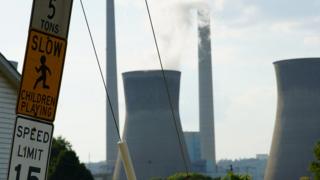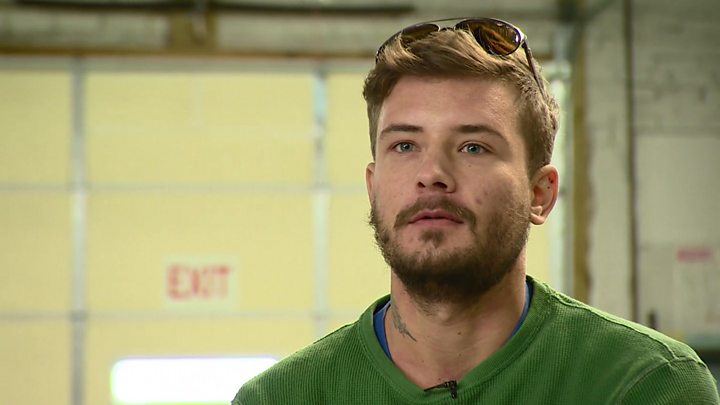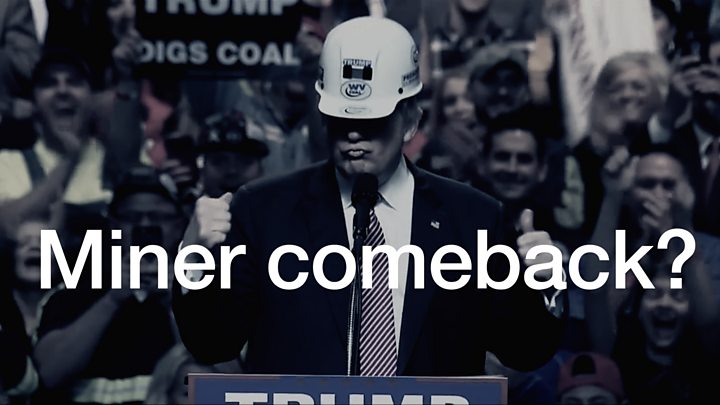Greenbrier Valley floods: Confronting climate change in Trump’s coal country
West Virginia, the heart of US coal country, is increasingly advocating for energy alternatives. …


It was the day the UK voted to leave the European Union but nobody cared about that in White Sulphur Springs.
On 23 June 2016 the residents of this small West Virginia town were fighting to survive.
They had been engulfed by a flash flood after torrential rain described by the US National Weather Service as a “one-in-a-thousand-year” storm.
Water, mud and debris coursed down from the steep, thickly-forested slopes of the Appalachian mountains into Greenbrier Valley where the town sits.
It smashed into homes and businesses, rupturing gas lines and setting properties ablaze.
One video posted on a local news website showed a burning house, ripped from its foundations, floating through the town.
By the time it was all over, 23 people across West Virginia were dead, most of them in Greenbrier County.
Ronnie Scott’s wife, Belinda, was one of them.
The 54-year-old was preparing pork chops for dinner when the floodwater hit. Amid the confusion she ended up trapped in the attic while her husband, unaware of her plight, helped to rescue other people.
When she told him by telephone that she was trapped, Mr Scott tried to get back to help her. In the chaos, it proved impossible.
“It causes nightmares,” he tells the BBC, “when you hear people screaming ‘please help me.'”
As he tried in vain to battle through the mud, “I heard ‘kaboom,'” says Mr Scott.
The house had exploded. Badly burned, Belinda ended up trapped above the water in a tree which her husband had planted years before.
More than three years later Mr Scott breaks down as he describes the moment he saw his wife in the specialist burns unit of a local hospital. “It was really nasty. I ended up on the floor crying,” he says.
“The 2016 flood in the Greenbrier Valley was absolutely catastrophic,” says Professor Nicolas Zegre, director of the Mountain Hydrology Laboratory at West Virginia University (WVU).
“Twenty three people killed. Millions of dollars worth of damage. Total disruption of the social system as well as economic system within that area. And incidentally we’ve had very large storms and floods almost every year since 2016 as well.”
While scientists tend not to link individual weather events to climate change, they have published a wealth of evidence that rising global temperatures make catastrophic floods such as the one which struck White Sulphur Springs more likely.
“With warming air temperatures the atmosphere can hold more water and there’s more evaporation,” says Prof Zegre, whose work is funded by the National Science Foundation. And that means “more frequent intense precipitation events”.
West Virginia is actually one of the few US states which does not, on average, show significant warming over the past century. Nor is there an overall precipitation trend during the 118-year period on record.
However the wider region, the country and the world have recorded rapidly rising average temperatures in recent years and the number of “extreme precipitation events” such as the 2016 downpour has been above average since the late 1990s.
In the northeastern region of the US, which in this context includes West Virginia, “extreme precipitation” increased by 71% from 1958 to 2012 according to the National Climate Assessment, a comprehensive US government study.
Those extremes are driven, says Prof Zegre, by mass production of energy and food pumping greenhouse gases into the atmosphere.
As a result, he says, the US is experiencing not only more-frequent, more-intense rainstorms, but also longer periods of drought.
“The critical thing to understand is that the entire system… is becoming more variable,” he says. “With the amount of people we have on this planet it is impossible to not have an impact on the earth and impact on the atmosphere.”
And yet many West Virginians seem to be struggling to come to terms with climate science, an attitude which appears to be tied to the state’s strong identity as a producer of coal.

Media playback is unsupported on your device
A study for the Yale Program on Climate Change Communication suggests a majority of Americans (53%) now think global warming is caused mostly by human activities.
But the researchers report that denial remains highest in the two states which produce the most coal, with just 38% of those surveyed in Wyoming and 39% in West Virginia agreeing that human activity is mostly to blame for rising temperatures.
Both states voted for the self-styled champion of coal, Republican Donald Trump, as president by large margins.
“Coal is the single largest economic activity that occurs in the state of West Virginia,” says Jason Bostic, vice president of the West Virginia Coal Association, a trade body. “About 50,000 folks are directly employed in the coal industry,” he says, adding that those jobs are often well-paid and support many more throughout the state.
For student campaigners here who joined in the global “climate strike” and rallied in the sunshine outside their university in Morgantown over the weekend, raising awareness about climate change here can be difficult.
“You can’t ignore that this state was built on coal,” says Abby Minihan, president of the student chapter of an environmental group, the Sierra Club, at West Virginia University. “It’s sometimes very hard to be an environmentalist in West Virginia because you can’t say to someone whose whole family has made their entire living off of coal, like, ‘well you’re wrong,'” she adds.
Ms Minihan may be struggling to find the most diplomatic way to deploy the message but that is, in fact, what the students are saying. After all, she says, “nothing else matters if you don’t have a planet to live on”.
According to Olivia Young, a student of astrophysics at WVU who also works as a science educator for a team funded by the US space agency, Nasa, a lack of decent scientific education is part of the problem.
“Not many places in West Virginia offer physics programmes in their high schools and those who do very few of them are taught by people actually trained in physics,” she says.
That is where the Nasa programme comes in. “We go out into schools and give science presentations and demos to little kids,” explains Ms Young.
One such experiment involves using glass beakers of bright bubbling liquid to demonstrate how carbon emissions warm the atmosphere. Sometimes, says the scientist, young children are confused and ask why their parents have told them that climate change isn’t real.
“I don’t try to step on parents’ toes,” she says, delicately, but “with the older students we do try to engage more in active conversations.
“We focus on showing the science, the scientific process, that this is why we’re thinking the way we are. We didn’t just come up with an idea. We actually have evidence to back it up.”
These young environmentalists are being challenged by the industry which they criticise.
“If they turn off the televisions, put their phones down, quit driving their cars, quit buying carpet, quit building houses, go live in a cave, that’ll solve the problem because nobody will make anything,” says Mr Bostic of the West Virginia Coal Association.
He tells us he does not accept the global scientific consensus on climate change and even if he did he would still argue that American coal “is not the problem”.
“Emissions in this country have dropped consistently since the 1970s,” he says, adding “they need to focus on the emerging economies of China, India and Africa.”
He is scornful too of the alternative energy solutions proposed by the climate strikers.
“You have to have consistent reliable electric power. That doesn’t come from windmills, doesn’t come from solar panels, doesn’t come from pixie dust, doesn’t come from unicorns and doesn’t come from well-wishes. That comes from fossil fuel, comes from coal, natural gas and even nuclear.”
Donald Trump recognises this, says Mr Bostic, praising the president’s roll-back of environmental regulations brought in by his predecessor Barack Obama.
“West Virginia came through a really difficult period during the Obama administration where good hard-working men and women lost their jobs for no other reason than for a short-sighted political agenda,” he says.
“So President Trump has been a relief to us. He’s been a breath of fresh air. We think he shares our values and we think he cares about the ability of this country to produce coal… and in turn produce goods for the American economy so that everybody’s a step closer to realising the American dream. Personally I love the guy.”

Media playback is unsupported on your device
However, official data do not appear to support claims of a major mining boom under President Trump. According to the Bureau of Labor Statistics, 50,800 people were directly employed in US coal mining in January 2017, the month Mr Trump took office. By June this year, the last month for which confirmed figures are available, the number had risen by just 2,200 to 53,000.
Nationwide there are 43 times as many people working for Walmart than are directly employed in the entire US coal industry.
Coal production edged up nationally from 660m tonnes (728m US tons) in 2016 to 703m tonnes (775m US tons) in 2017 before dropping back to 685m tonnes (756m US tons) in 2018. So far in 2019 it is down again, according to the US Energy Information Administration (EIA) website and remains well below both recent and historical averages. And domestic coal consumption has actually fallen since Mr Trump took office.
Still, the president continues to prioritise the extraction of fossil fuels over environmental concerns as he campaigns for re-election next year.
That may play well with Republicans but it could be a message which makes it harder for him to win over other voters. The share of Americans who say climate change is a “major threat” to the well-being of their country rose from 40% in 2013 to 57% in 2019, according to a poll for the Pew Research Center.
For Ronnie Scott, the issue is deeply personal. In the memorial park where his home once stood he hugs the tree where rescuers found his wife. Mr Scott, like so many of his fellow Americans, is a devout Christian.
“I’m going to be with Belinda again,” he says. “And when we meet we won’t have to worry about floods, fires, all of the bad stuff that goes on in this world.”
And then, tears in his eyes, he asks: “I want to know what we’re going to do about this global warming?
“It’s terrible. People need to change their way of living.”


